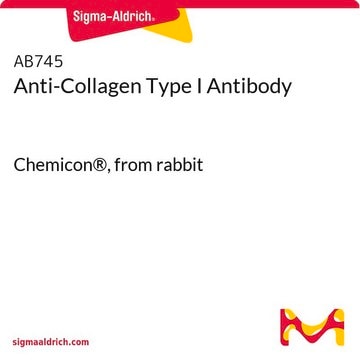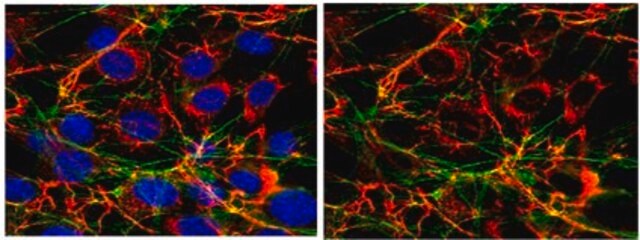AB765P
Anti-Mouse Collagen Type I Antibody
Chemicon®, from rabbit
Synonim(y):
Anti-CAFYD, Anti-EDSC, Anti-OI1, Anti-OI2, Anti-OI3, Anti-OI4
About This Item
Polecane produkty
pochodzenie biologiczne
rabbit
Poziom jakości
forma przeciwciała
serum
rodzaj przeciwciała
primary antibodies
klon
polyclonal
reaktywność gatunkowa
mouse
producent / nazwa handlowa
Chemicon®
metody
ELISA: suitable
immunohistochemistry: suitable
radioimmunoassay: suitable
western blot: suitable
izotyp
IgG
numer dostępu NCBI
numer dostępu UniProt
Warunki transportu
dry ice
docelowa modyfikacja potranslacyjna
unmodified
informacje o genach
human ... COL1A1(1277)
Opis ogólny
Specyficzność
Immunogen
Zastosowanie
Cell Structure
ECM Proteins
1:500 dilution of a previous lot detected Collagen Type I on 10 μg of Mouse Liver lysate.
Immunohistochemistry:
1:40 dilution of a previous lot for immunofluorescent staining of frozen mouse skin and liver tissues.
RIA:
A 1:200 dilution of a previous lot was used in RIA.
ELISA:
A previous lot of this antibody was used in ELISA
Opis wartości docelowych
Powiązanie
Postać fizyczna
Przechowywanie i stabilność
Komentarz do analizy
Mouse skin and mouse liver tissues
Inne uwagi
Informacje prawne
Oświadczenie o zrzeczeniu się odpowiedzialności
Not finding the right product?
Try our Narzędzie selektora produktów.
Kod klasy składowania
12 - Non Combustible Liquids
Klasa zagrożenia wodnego (WGK)
WGK 1
Temperatura zapłonu (°F)
Not applicable
Temperatura zapłonu (°C)
Not applicable
Certyfikaty analizy (CoA)
Poszukaj Certyfikaty analizy (CoA), wpisując numer partii/serii produktów. Numery serii i partii można znaleźć na etykiecie produktu po słowach „seria” lub „partia”.
Masz już ten produkt?
Dokumenty związane z niedawno zakupionymi produktami zostały zamieszczone w Bibliotece dokumentów.
Klienci oglądali również te produkty
Nasz zespół naukowców ma doświadczenie we wszystkich obszarach badań, w tym w naukach przyrodniczych, materiałoznawstwie, syntezie chemicznej, chromatografii, analityce i wielu innych dziedzinach.
Skontaktuj się z zespołem ds. pomocy technicznej











